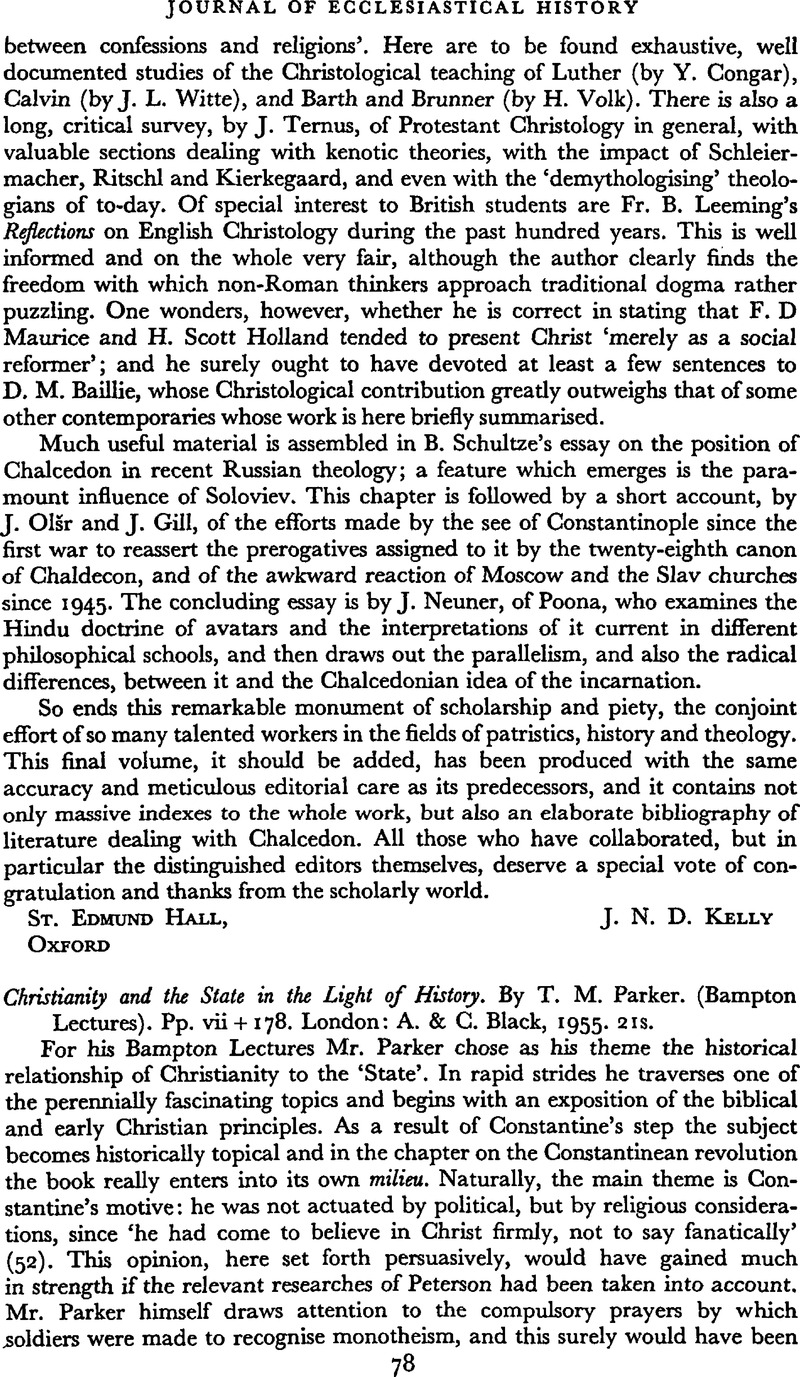Published online by Cambridge University Press: 25 March 2011

page 79 note 1 Cf. Peterson, E., ‘Der Monotheismus als politisches Problem’ in Theol. Traktate, Munich 1951, 49 ff.Google Scholar; idem, ‘Christus als Imperator’ ibid., 151 ff. Cf. also most recently Ehrhardt, A., ‘Constantin d. Gr., Religionspolitik und Gesetzgebung’ in Savigny Zeitschr., Roman. Abt., LXXII. (1955), 127–90.Google Scholar
page 79 note 2 Cf. the literature about this quoted by Congar, Y., Neuf cents ans après (Collection Irénikon, 1954), 12Google Scholar, to which should be added Straub, J. A., Vom Herrschcrideal in der Spälantike, Freiburg 1939, 244.Google Scholar
page 79 note 3 A claim approaching that to be ἰσόθεος, see Ehrhardt, A. in Studi in onort P. de Francisci, Milan 1955, iv. 441.Google Scholar In the fourth and fifth centuries θειος meant not only ‘divine’, but more often than not ‘imperial’, cf. Jones, A. H. M. in Harvard Theol. Rev., XLVI. (1953), 172.Google Scholar
page 79 note 4 In the imperial decree of 452 A.D. each of the two emperors was styled ‘pontifex inclytus’, cf. Hardouin, Conc., coll., ii. 659. The emperor Anastasius, the contemporary of Gelasius I, also called himself ‘pontifex inclytus’, see Thiel, A., Epp. pontificum Romanorum genidnae, Braunsberg 1862, 765.Google Scholar Cf. also the acclamation to the emperor in the Council of Chalcedon: τῳ ἱερει τῳ βασιλει, τς κκλεσίας σὺ ρθωσας, νικητ πολεμίων, διδάσκαλε πίσεως (sacerdoti, imperatori (multos annos), ecclesias tu erixisti, victor bellorum, doctor fidei), Mansi, Coll. conc., vii. 177A. The ‘universal patriarch’ (of Constantinople) said during the Council of Constantinople (536): ‘Nihil eorum quae in sanctissima ecclesia moventur, convenit fieri praeter opinionem et jussum ipsius (scil. imperatoris)’: Mansi, viii. 969A. About the attempt to make this Council ecumenical, see Devreesse, R. in Misc. G. Mercati, III. (1946), 1–15.Google Scholar
page 79 note 5 Of the more recent works on the subject mention should be made, apart from those by Toumanoff, C. and Schnitzler, of H. Rahner, Abendl. Kirchenfreiheit, Einsiedeln 1944Google Scholar, and the excellent essays in Das Konzil von Chalkedon, ed. Grillmaier-Bacht, , Würzburg, i-iii. (1951–1955).Google Scholar Cf. now also Michel's, A. long studies on ‘Die Kaisermacht in der Ostkirche’ in Ostkirchl. Studien, II (1953) ff.Google Scholar About Byzantine symbolism in the court ceremonial cf. Fichtenau, H. in Mitt. d. oest. Inst.f. Geschichtsforschung, LIX. (1951), 1 ff.Google Scholar and the literature quoted there. The laws, says Justinian, emanate from ‘nostro divino ore’ (Cod., I., xvii. 1.6).
page 80 note 1 Conceived as societas fidelium by Nicholas I (MGH. Epp. vi. Ep. 1, p. 267); as populus Dei by Adrian II. (ibid., Ep. 21, p. 725); as respublica Christiana by John VIII (MGH. Epp. vii, Ep. 150, p. 126). Cf. Gregory VII in Reg. ii. 73, p. 234 (ed. E. Caspar): ‘Corpus Christi, quod est fidelium congregatio.’ Innocent III in Reg. ii. 133: ‘Licet unum sit corpus ecdesiae in quo Christus est caput et universi fiddes sunt membra, ille tamen qui a Christo petra dictus est, Petrus …;’ idem, Reg. i. 92: ‘Cum omnes unum corpus simus in Christo …;’ cf. also Reg. i. 345: ‘Licet commissa nobis a Domino potestatis ecclesiae plenitudo universis Christi fidelibus nos constituent debitores …’ and the arengae in Reg. i. 309, 354, 409; ii. 20, 83, and in many other places.
page 81 note 1 For a discussion of the medieval concept of the Church and its consequences see Hauck, A., ‘Die Rezeption und Umbildung der allgemeinen Synode im Mittelalter’ in Hist. Vierteljahrschrift, X. (1907), 465 ff.Google Scholar (a most important contribution) and Merzbacher, F., ‘Wandlungen des Kirchenbegriffs im Spätmittelalter’ in Savigny Zeitschrift, Kanon. Abt., XXXIX (1953), 274–361Google Scholar; see p. 279: ‘Der Kirchenbegriff selbst erweist sich als die “crux” nicht allein der Theologen, sondern ebenfalls im gleichen Masse der Kanonisten und Historiker.’
page 81 note 2 During his trial Maximus the Confessor dealt with the statement: ‘Ergo non est, omnis christianus imperator etiam sacerdos?’ Mansi, xi. 6B. P. G. xc. 115.
page 81 note 3 Hence the interchangeability of lex and canon in imperial legislation, cf. Wenger, L., ‘Canon in den römischen Rechtsquellen’ in Sitzungsberichte d. Akad. d. Wiss., Wien CCXX. (1943), 88 ff.Google Scholar, 170 f.
page 81 note 4 Cf. the monarchic idea, suitably clothed in contemporary terms, as shown in the titles (and actions) of, say, Otto III or Henry II on the lay side, and the exposition of the monarchic idea by, say, Gregory IX (MGH. Epp. selectae XIIIs., i. 604, no. 703) and by Innocent IV (Acta imperii inedita, ii. 698, no. 1035) on the papal side.
page 81 note 5 This is precisely one of the reasons for the weakness of the royalist position in a thorough Christo-centric world. Nulla potestas nisi a Deo, equally strongly insisted on by royalists and hierocrats alike, gave the latter automatically a preponderance, especially when viewed against the jurisdictional primacy of the Roman Church. Again, making the ‘universitas civium’ the basis of political power, resulted in revolutionising the traditional outlook.